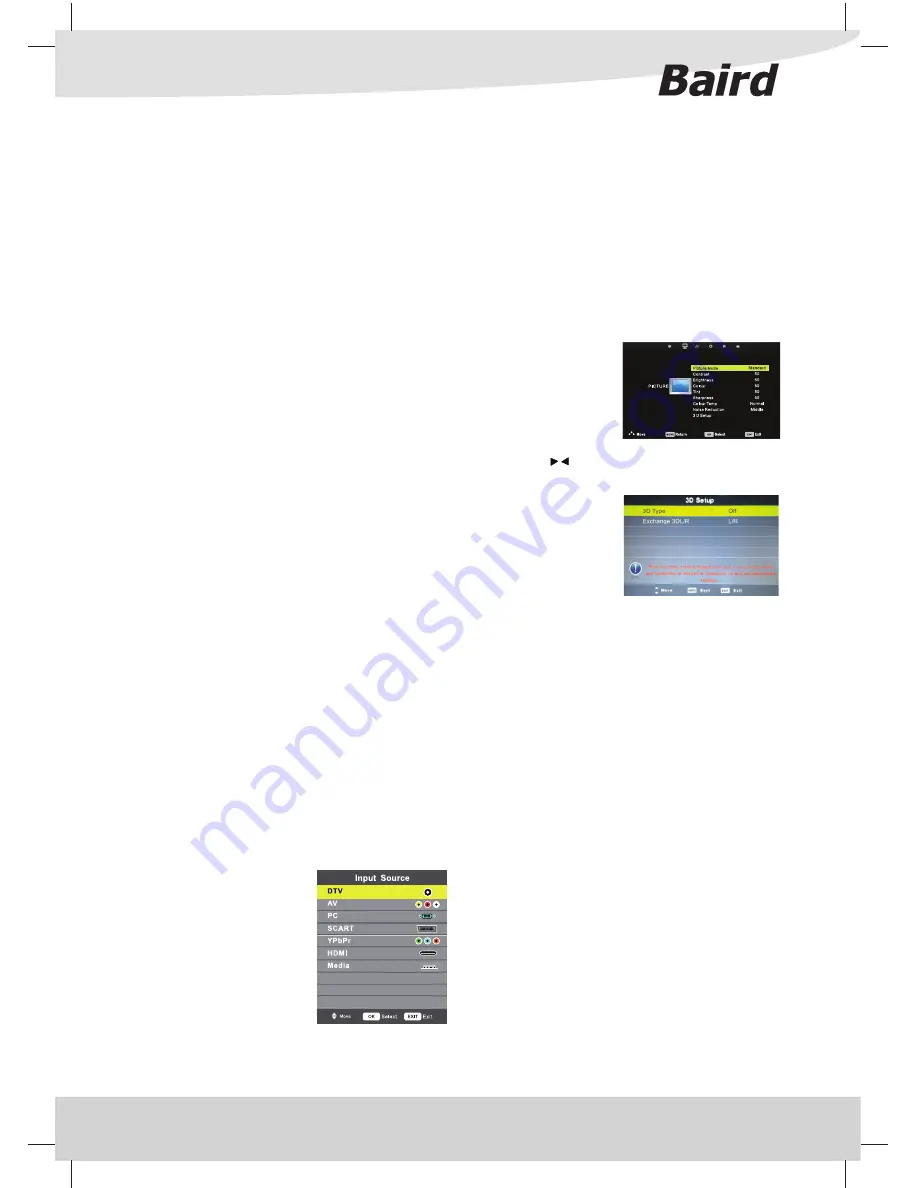
15
3D MODE
TV Menu Operation
3D Viewing Safety
Viewing 3D images through a television and 3D glasses
aff ects diff erent people in diff erent ways. Please read
and understand the safety warnings in the ‘safety
information’ section of this manual before operating
this television in 3D mode.
What is 3D
3D imaging uses a process known as stereography
to generate the perception of a 3 dimensional image
from a pair of 2 dimensional images. Each stereograph
image pair contains a specific image for the viewer’s
left eye and another image of the same scene, from a
slightly diff erent angle for the viewer’s right eye. The
slight variations between the left and right images
of the same scene will ‘trick’ the viewer’s brain into
constructing a 3 dimensional image just as it would
process a normal image from both eyes. The 3D System
used in this TV is the passive type which menas the
glasses provided do not require batteries to provide
your 3D experience.
Connecting a 3D Source
A 3D source is required in order for you to be able
to view 3D images on your television. A 3D blu-
ray player(with a 3D disc) connected using a 1.4
HDMI cable or 3D transmission directly to your TV is
necessary to allow you to view 3D images. Your 3D
television will not produce 3D images unless it has a
3D source and it will not produce 3D images from 2D
content.
Enabling 3D mode on your Television
Do not enable 3D mode on your television or use
your 3D glasses in 2D mode otherwise you will see a
distorted image.
To enable 3D mode on your television, ensure that you
have already been through the initial set up process as
outlined in this manual.
To view 3D content:
1. Connect your 3D source (such as a BLU-RAY player)
to the HDMI connection using a 1.4 HDMI cable. Turn
your 3D source on.
2. Press the input button on
your remote control and
select the relevant HDMI
connection from the drop
down menu as shown in
fig.1.
• Press
▼
/
▲
button to select
the HDMI connection for
your 3D source;
• Press OK/
►
button to enter the input source;
• Press OK button to enter the input source;
3. Press ‘ play’ on your 3D source to start playing the 3D
content, the image you will see on your screen will
be fuzzy.
The TV may automatically select the correct 3D
mode for playing your content, but this is dependent
upon your 3D source. If it does not display correctly,
refer to point 5 and manually select ‘framepacking’
mode, (this is generally the default for the UK).
4. Put on the 3D glasses for 3D eff ect
5. Select “3D Type” option in the PICTURE menu and
you will see a box in the
top left hand corner of
your television screen
that shows you the
3D mode that your
television is in.
Pressing the
button on your remote control will
show you more options for the dierent types of 3D
mode.
(Available 3D Type:
Off ,Side by Side,Line by
Line, Top Bottom,Frame
Packing) Select the
‘Frame Packing’ 3D
Mode( this is generally
the default for UK content).
6. 3D mode has now been enabled on your television .
At this point you should put on your 3D glasses .
If viewing 3D content directly from a television
transmission, follow steps 3 to 5 above to enable the
correct 3D mode and begin viewing.
Using your 3D glasses
There are 2 pairs of linear polarized 3D glasses supplied
with this television. Linear polarized glasses require
you to maintain your head in a vertical position.
Tilting your head left to right can break the 3D eff ect
because the content relies on one eye seeing the
vertically polarized image and the second eye seeing
the horizontally polarized image. When the head is
tilted the polarized lenses are no longer in line with the
double image on the screen.
3D Viewing Guidelines
For the best 3D viewing experience stay within the
viewing angle and at the optimum distance from your
television.
Ensure that there are no obstacles between the 3D
glasses and the television.
Viewing of 3D images on your television may be
aff ected by fluorescent lights or direct sunlight. Please
ensure that fluorescent lighting is switched off and
sources of direct sunlight are blocked before viewing
3D content.




























